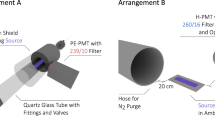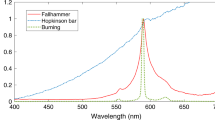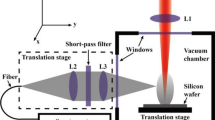Abstract
ARISING out of work1 on the disappearance of the nitrogen afterglow by heating the activated gas at various pressures, it may be of interest to record results which indicate limits for the production of a like phenomenon observed by Lord Rayleigh2, namely, the quenching of the afterglow due to cooling by liquid air. With a condensed discharge in a Crookes' tube connected in series with a long glass spiral S, and a small bulb containing powdered iodine, the activated gas excited the characteristic iodine luminescence even when the afterglow in the observation spiral S was feeble; both disappeared when S was cooled by liquid air, in agreement with Rayleigh's observation2. That this phenomenon is, however, restricted to low pressures is shown by the fact that when the gas pressure was increased progressively from 0·1 mm. the Rayleigh quenching in S tended to be less marked; was uncertain near 30 mm. and not observed above 40 mm.
This is a preview of subscription content, access via your institution
Access options
Subscribe to this journal
Receive 51 print issues and online access
$199.00 per year
only $3.90 per issue
Buy this article
- Purchase on Springer Link
- Instant access to full article PDF
Prices may be subject to local taxes which are calculated during checkout
Similar content being viewed by others
References
Joshi and Purshotham, Proc. Ind. Acad Sci., 19, No. 4 (1944).
Strutt, R. J., Proc. Phys. Soc., 23, 66 (1910); Proc. Roy. Soc., A, 85, 219 (1911). Trowbridge, Phys. Rev., 23, 279 (1906).
Author information
Authors and Affiliations
Rights and permissions
About this article
Cite this article
JOSHI, S., PURSHOTHAM, A. Rayleigh Quenching of Active Nitrogen. Nature 154, 115–116 (1944). https://doi.org/10.1038/154115b0
Issue Date:
DOI: https://doi.org/10.1038/154115b0
Comments
By submitting a comment you agree to abide by our Terms and Community Guidelines. If you find something abusive or that does not comply with our terms or guidelines please flag it as inappropriate.



